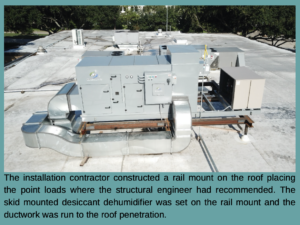A good customer needed help solving dehumidification issues with two of their packaging and compounding pharmacies in Houston. Both had unique requirements that made it a challenge to find the best solution for each application.
Tight Humidity Specifications
The primary function of our customer’s two pharmacies was to repackage and mix bulk medicines for use by hospitals. The regulations governing the operations of these types of pharmacies include very tight humidity specifications. This is to prevent direct contamination of the product with moisture and to prevent growth of pathogens in the facility. Any deviation from the humidity specification would mean contamination of millions of dollars of product.
The customer had been previously convinced by a contractor that a plenum refrigerant style dehumidifier would be able to provide the humidity control that they needed. However, after these dehumidifiers were installed, the pharmacy was out of specs on high humidity days and had not been able to start production. Our recommendation for these pharmacy applications was to use an Innovative Air Technologies desiccant style dehumidifier to tightly control humidity levels.
Moisture Loads
The first challenge we had in solving dehumidification issues was to determine the moisture load on each pharmacy clean room. We had to determine the amount of moisture coming from people, product, building type and penetrations. The challenge with the moisture load from penetrations was the requirement to keep the pharmacies under positive pressure. That meant that the amount of moisture coming from penetrations was actually from the outside make-up area that was needed to maintain positive pressure. Because of the large variation in relative humidity in Houston throughout the year, we needed to assume a high level of moisture in the make-up air. With the moisture load determined from all sources, we were able to size the units needed to maintain the tight humidity specifications for both pharmacies.
Post Cooling Options
Both desiccant dehumidifiers required post cooling functions to remove the heat from the drying process. For the first pharmacy, we chose to use direct compression air conditioning to provide the cooling. The second pharmacy had a chilled water plant that serviced the air handler. We determined that there was sufficient excess capacity in the chilled water plant to provide the required amount of cooling for the desiccant dehumidifier. By utilizing the existing chilled water capacity, were able to reduce both the initial cost of the dehumidifier and the annual operating costs.
Air Distribution
Both pharmacies presented unique challenges for determining how the dehumidified air would be distributed evenly throughout the facility. One pharmacy had a plenum above the clean room from which HEPA filtered fans supplied air to the facility. For this application, we needed to make sure that the supply and return for the desiccant dehumidifier were located far enough apart to provide adequate air mixing without any short circuiting of air flow between the two.
The second pharmacy had a central air handler with one large duct that fed all the distribution points in the facility and one large duct that collected the return air. Make-up air was provided by a separate dedicated outdoor air system (DOAS). For this application, we determined that the desiccant dehumidifier would replace the DOAS unit and provide the required amount of make-up air in addition to removing moisture load from the facility.
The supply air from the desiccant dehumidifier would be located downstream of the air handler supply air and the desiccant return air would be upstream of the air handler return air. To make that configuration work, we sized the blower for the desiccant dehumidifier to overcome the system pressure of the air handler. Otherwise, the output from the desiccant dehumidifier would have been dramatically reduced.
Mounting Locations
Where to mount the desiccant dehumidifiers also presented a challenge. For the pharmacy with the plenum, a roof top mounting position was determined to be the best. We were able to utilize an existing roof top penetration to run the supply and return air ducts. Due to the weight of the unit, we hired a professional structural engineer to certify that the roof could support the weight and to identify the best mounting location.

The second pharmacy had a fenced area behind the building for the air handler. To reduce the length of ductwork required for the desiccant dehumidifier, the best spot was next to the air handler. To make room, the DOAS unit that was no longer needed was removed. We also upgraded the natural gas service to accommodate the amount needed for the desiccant dehumidifier. Although the customer initially wanted to use electric heat for the drying process, we convinced them that upgrading to use natural gas was a long-term cheaper solution than electricity.

Conclusion
After the new desiccant dehumidifier units were installed, the customer was able to hold humidity levels within specifications. As a result, they were able to start production and have not had any issues with product contamination.
This was a good example of how the cheapest solution is not always the best solution when humidity control is critical to the success of the business. We were able to overcome several challenges to find the best option from both an operational and a financial perspective. The Eldridge team did a great job solving dehumidification issues and creating another successful environment for a customer.
